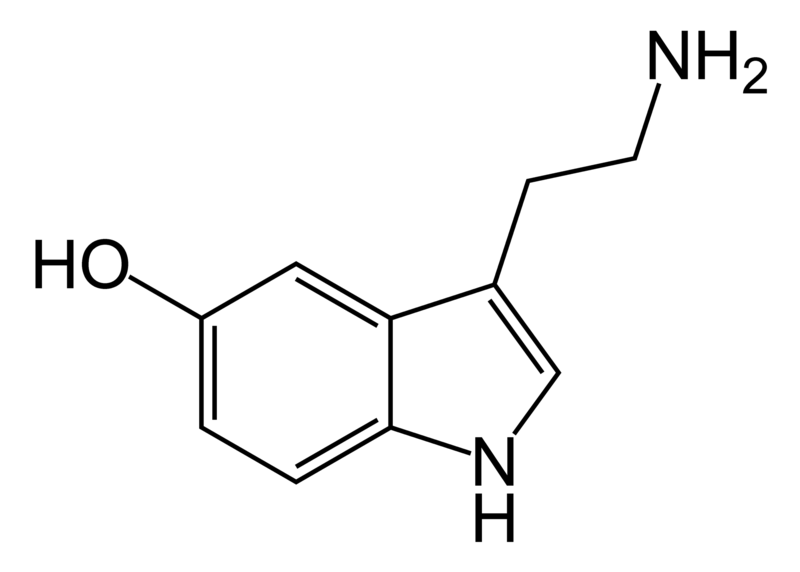5-HT receptor
Editor-In-Chief: C. Michael Gibson, M.S., M.D. [1]
Overview
In the field of neurochemistry, 5-HT receptors are receptors for the neurotransmitter and peripheral signal mediator serotonin, also known as 5-hydroxytryptamine or 5-HT.[1] 5-HT receptors are located on the cell membrane of nerve cells and other cell types including smooth muscle in animals, and mediate the effects of serotonin as the endogenous ligand and of a broad range of pharmaceutical and hallucinogenic drugs. 5-HT receptors affect the release and activity of other neurotransmitters such as glutamate, dopamine and GABA. 5-HT2A receptors increase the activity of glutamate in many areas of the brain, while some other serotonin receptors have the effect of suppressing glutamate. Increased stimulation of 5-HT2A receptors seem to oppose the therapeutic actions of increased stimulation of other serotonin receptors in anti-depressant and anxiolytic treatments.[2]

Classification
With the exception of the 5-HT3 receptor, a ligand gated ion channel, all other 5-HT receptors are G protein coupled seven transmembrane (or heptahelical) receptors that activate an intracellular second messenger cascade.
Families
| Family | Type | Mechanism |
| 5-HT1 | Gi/Go coupled | decreasing cellular levels of cAMP |
| 5-HT2 | Gq/G11 coupled | increasing cellular levels of inositol trisphosphate (IP3) and diacylglycerol (DAG) |
| 5-HT3 | ligand-gated Na+ and K+ cation channel | depolarizing plasma membrane |
| 5-HT4 | Gs coupled | increasing cellular levels of cAMP |
| 5-HT5A | G protein coupled; the primary coupling appears to be through Gi/o | inhibiting adenylate cyclase activity.[3] |
| 5-HT6 | Gs coupled | increasing cellular levels of cAMP |
| 5-HT7 | Gs coupled | increasing cellular levels of cAMP |
Specific proteins/genes
Within these general classes of 5-HT receptors, a number of specific types have been characterized:
| Receptor | Gene | Actions | Agonists | Antagonists |
|---|---|---|---|---|
| 5-HT1A | HTR1A |
|
||
| 5-HT1B | HTR1B |
|
|
|
| 5-HT1D | HTR1D |
|
|
|
| 5-HT1E | HTR1E | |||
| 5-HT1F | HTR1F | |||
| 5-HT2A | HTR2A |
|
||
| 5-HT2B | HTR2B |
|
|
|
| 5-HT2C | HTR2C |
|
|
|
| 5-HT3 | HTR3A, HTR3B |
|
| |
| 5-HT4 | HTR4 |
|
| |
| 5-HT5A | HTR5A |
|
unknown | |
| 5-HT6 | HTR6 |
|
|
SB271046[6] |
| 5-HT7 | HTR7 |
|
|
|
Note that there is no 5-HT1C receptor since, after the receptor was cloned and further characterized, it was found to have more in common with the 5-HT2 family of receptors and was redesignated as the 5-HT2C receptor.
Therapeutic modulation
Various drugs are used to modulate the 5-HT system including some antidepressants, anxiolytics, antiemetics, antipsychotics and anti-migraine agents.
External links
- Serotonin+Receptors at the US National Library of Medicine Medical Subject Headings (MeSH)
- "5-Hydroxytryptamine Receptors". IUPHAR Receptor Database. International Union of Basic and Clinical Pharmacology. Retrieved 2008-04-11.
- Glennon RA, Dukat M, Westkaemper RB (2000-01-01). "Serotonin Receptor Subtypes and Ligands". American College of Neurophyscopharmacology. Retrieved 2008-04-11.
- Rubenstein, LA, Lanzara RG (2005-02-16). "Activation of G protein-coupled receptors entails cysteine modulation of agonist binding". Cogprints. Retrieved 2008-04-11.
- Frazer A, Hensler JG (1999). "Chapter 13: Serotonin Receptors". In Siegel GJ, Agranoff BW, Albers RW, Fisher SK, Uhler MD, editors. Basic Neurochemistry: Molecular, Cellular, and Medical Aspects. Philadelphia: Lippincott-Raven. pp. pages 263-292. ISBN 0-397-51820-X. Retrieved 2008-04-11.
- Wesołowska A (2002). "In the search for selective ligands of 5-HT5, 5-HT6 and 5-HT7 serotonin receptors" (PDF). Polish Journal of Pharmacology. 54 (4): 327–41. PMID 12523486.
References
- ↑ Hoyer D, Clarke DE, Fozard JR, Hartig PR, Martin GR, Mylecharane EJ, Saxena PR, Humphrey PP (1994). "International Union of Pharmacology classification of receptors for 5-hydroxytryptamine (Serotonin)". Pharmacol. Rev. 46 (2): 157–203. PMID 7938165.
- ↑ Marek GJ, Carpenter LL, McDougle CJ, Price LH (2003). "Synergistic action of 5-HT2A antagonists and selective serotonin reuptake inhibitors in neuropsychiatric disorders". Neuropsychopharmacology. 28 (2): 402–12. doi:10.1038/sj.npp.1300057. PMID 12589395.
- ↑ 3.0 3.1 Nelson DL (2004). "5-HT5 receptors". Current drug targets. CNS and neurological disorders. 3 (1): 53–8. PMID 14965244.
- ↑ Glennon RA, Hong SS, Dukat M, Teitler M, Davis K (1994). "5-(Nonyloxy)tryptamine: a novel high-affinity 5-HT1D beta serotonin receptor agonist". J. Med. Chem. 37 (18): 2828–30. doi:10.1021/jm00044a001. PMID 8071931.
- ↑ Rang, H. P. (2003). Pharmacology. Edinburgh: Churchill Livingstone. ISBN 0-443-07145-4. Page 187
- ↑ "Target Schizophrenia - Possible future developments". The Association of the British Pharmaceutical Industry. Retrieved 2008-04-11.